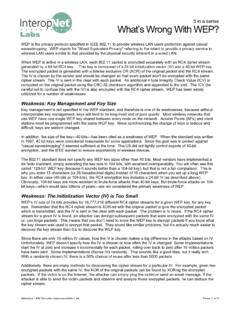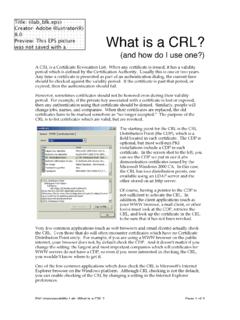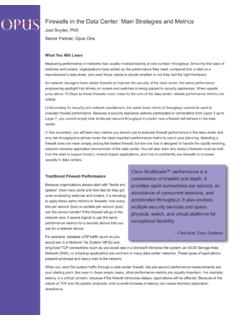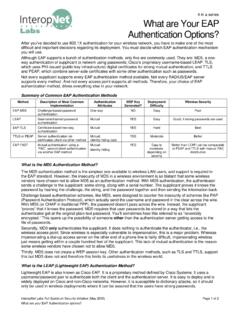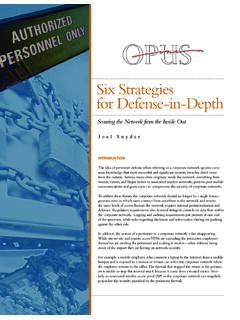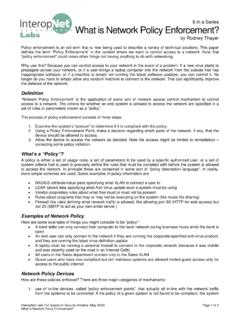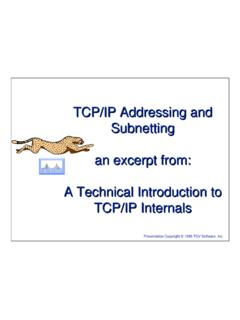Transcription of TTLS and PEAP Comparison - opus1.com
1 9 in a SeriesWireless LAN Security Interoperability LabPage 1 of 2 ttls and PEAP ComparisonTTLS and PEAP Comparisonby Matthew GastBroadly speaking, the history of security is an attempt to address two major problems. The first problem isthat the protocols used to authenticate network users were not strong, so unauthorized users could easily accessnetwork resources. Second, the Wired Equivalent Privacy (WEP) system proved insufficient for a number of well-publicized reasons. Our white paper What s Wrong With WEP? discusses these in detail. In response to userconcerns about weak security, the industry began developing a series of stronger protocols for use with wirelessLANs. The key standard is IEEE , which provides both stronger authentication and a mechanism forderiving and distributing stronger keys to bolster Protocol RequirementsThe dual requirement of strong encryption to prevent eavesdropping and mutual authentication to ensure thatsensitive information is transmitted only over legitimate networks, must drive your wireless user authentication credentials over a wireless network must be done with great care because trafficinterception is much easier.
2 Attackers require physical access to the network medium to intercept transmissions,but radio waves cannot easily be confined to a physical facility. Without the security of a direct physicalconnection, cryptographic safeguards must be built into the protocols for two reasons. First, and most obvious, isto prevent attackers from recovering user credentials as they travel over the radio link. Secondly, unauthorized"rogue" access points may be set up in an attempt to collect credentials from unsuspecting users. Cryptographycan provide the necessary assurance that users are connecting to an authorized and secured is based on the Extensible Authentication Protocol (EAP), and so it offers the choice of several methodsto protect authentication exchanges.
3 In practice, authentication methods based on the IETF's well-knownTransport Layer Security (TLS) standard can satisfy strict encryption and authentication requirements. Three TLS-based protocols have been developed for use with EAP and are suitable for deployments with wireless LANs:EAP-Transport Layer Security (EAP-TLS), Tunneled Transport Layer Security ( ttls ), Protected EAP (PEAP).EAP-TLSEAP-TLS uses the TLS handshake as the basis for authentication. TLS itself has many attributes that make itattractive for security-related use. It is well documented and has been analyzed extensively, and cryptanalysis ofthe protocol has not yet revealed significant weaknesses in the protocol. TLS performs authentication byexchanging digital certificates.
4 The server presents a certificate to the client. After validating the server'scertificate, the client presents a client certificate. Naturally, the certificate should be protected on the client by apassphrase, PIN, or stored on a smart card, depending on the central role of certificates is the Achilles heel of EAP-TLS. If no PKI exists, it must be deployed before EAP-TLS can be used in a network. Certificate management is a time-consuming and cumbersome administrativetask, especially because certificates must be revoked as users lose access to the wireless network. In addition toissuing certificates, on-line validity checks are mandatory. Furthermore, an existing PKI may be insufficientbecause most EAP-TLS implementations require the presence of certain attributes that were not defined whenearly PKI systems were rolled out.
5 A final risk is that EAP-TLS by itself protects the user's authentication material,but not the user identity. The bottom line is that EAP-TLS is secure, but the requirement for client certificates is alarge hurdle that makes ttls and PEAP Tunneling with ttls and PEAPBoth ttls and PEAP use the inherent privacy of the TLS tunnel to safely extend older authentication methods,such as username/password or token card authentication, to the wireless network. Both are two-stage protocolsthat establish a strongly encrypted "outer" TLS tunnel in stage one and then exchange authentication credentialsthrough an "inner" method in stage two. Both ttls - and PEAP-capable RADIUS servers can be used withexisting authentication systems. RADIUS proxy abilities can extend existing databases, directories, or one-timepassword systems for use with wireless uses the TLS channel to exchange "attribute-value pairs" (AVPs), much like RADIUS.
6 The flexibility of theAVP mechanism allows ttls servers to validate user credentials against nearly any type of authenticationmechanism. ttls implementations today support all methods defined by EAP, as well as several older methods(CHAP, PAP, MS-CHAP and MS-CHAPv2). PEAP uses the TLS channel to protect a second EAP exchange,9 in a SeriesWireless LAN Security Interoperability LabPage 2 of 2 ttls and PEAP Comparisoncalled the "inner" EAP exchange. Most supplicants support EAP-MS-CHAPv2 for the inner exchange, whichallows PEAP to use external user databases. Other common EAP methods supported by PEAP supplicants areEAP-TLS and generic token card (EAP-GTC).PEAP's major advantage is support from Microsoft, and therefore, built-in support from the operating support is a standard feature in Windows XP and available as a Microsoft feature pack for Windows supplicants (wireless clients) are tightly integrated with the base operating system and can thereforeprovide single sign on capabilities by using the same user credentials for both Windows sign-on and wireless LANauthentication.
7 Microsoft supplicants, however, do not support the use of token cards. Cisco PEAP supplicantsdo support EAP-GTC, but Cisco and Microsoft have implemented PEAP in different ways that are not wireless LAN deployments require PKI to be deployed in a supporting role. Certificates are used toestablish a secure authentication channel in any case. One of the first decisions to be made is whether the costof issuing client certificates is one worth accepting. In many cases, an existing PKI can be used to support awireless LAN deployment. Organizations which have not already deployed PKI should consider ttls or PEAP instead, with an appropriate inner authentication : Comparison of TLS authentication methodsTLSTTLSPEAPS pecificationRFC 2716 Internet-Draft, 11/2002 Internet-Draft, 3/2003 SoftwareClient implementationsCisco, Funk,Meetinghouse, Microsoft,Open1X (open source)Funk, MeetinghouseCisco, Microsoft, Funk,MeetinghouseSupported client platformsLinux, Mac OSX,Windows 95/98/ME,Windows NT/2000/XP,Mac OS XLinux, Mac OS X,Windows 95/98/ME,Windows NT/2000/XPLinux, MacOS X,WindowsAuthentication serverimplementationsCisco ACS, FunkOdyssey, , MeetinghouseAEGIS, Microsoft IAS,FreeRADIUSFunk, Meetinghouse,InterlinkCisco ACS, Microsoft IAS,Interlink ,Meetinghouse, FunkAuthentication Certificates onlyCHAP, PAP, MS-CHAP,MS-CHAPv2, and EAPmethodsEAP methods.
8 CommonlyMS-CHAPv2, generictoken card, and EAP-TLSP rotocol operationsBasic protocol structureEstablish TLS session andvalidate certificates onboth client and serverTwo phases:(1) Establish TLS betweenclient and ttls server(2) Exchange attribute-value pairs between clientand serverTwo parts:(1) Establish TLS betweenclient and PEAP server(2) Run inner EAPexchange over TLS tunnelFast session reconnectNoYesYesWEP integrationYes; generated by RADIUS server and passed through MS-MPPE attributesPKI/CertificatesServer certificateRequiredRequiredRequiredClien t certificateRequiredOptionalOptionalVerif icationCertificate chain validation; OSCP is supported by the protocolEffect of private keycompromiseRe-issue all certsRe-issue all server certificates and new CA certClient and user authAuthentication directionMutual: digital certificatesboth waysMutual: Certificate toclient, tunneled method forclientMutual: Certificate toclient, tunneled method forclientProtection of user identityNoYesYes
